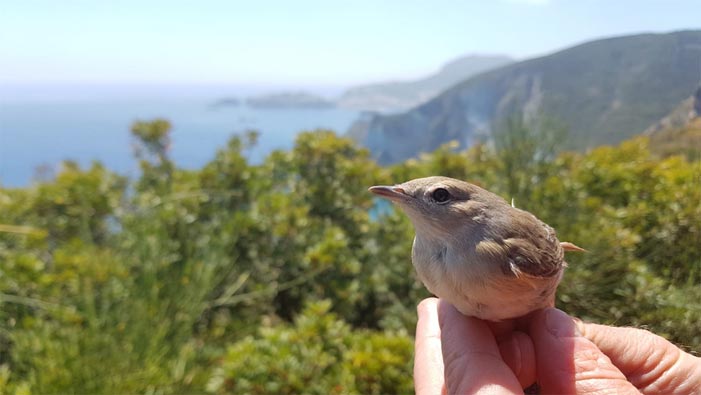Out of Africa: migratory birds fly to Europe earlier and earlier

Photo: CISCA
In response to climate change, the spring migration of many migratory birds is shifting ever further forward. However, according to a study presented by an international research team led by Vetmeduni Vienna, this change does not follow a uniform pattern. On the contrary, closer inspection reveals a complex picture: Essential for the start of the migration is the region of wintering.
It is known from previous studies that migratory birds bring forward their spring arrival in European breeding areas due to climate change. In addition, those species that are less able to adapt their migratory time suffer a decline in their population in Europe. It is therefore reasonable to assume that the cause of their decline is the inability to adapt the timing of their migration.
Depending on the place of wintering, migratory birds will arrive sooner or later
In order to answer these and other questions, a research group led by Ivan Maggini and Leonida Fusani from the Konrad Lorenz Institute for Comparative Behavioral Research at Vetmeduni Vienna investigated the timing of bird migration in the central Mediterranean region. They did so on the island of Ponza in the Tyrrhenian Sea, about 50 km from the Italian coast. A large proportion of the Central and Northern European migratory birds stop on this island to recover from an almost 500 km long sea crossing. Fusani and Maggini – in collaboration with an international research team on Ponza – analyzed the migratory periods of the 30 species most frequently counted on the island during the last 18 years. Ivan Maggini said: “As a general pattern, we were able to observe an advance of the migration time. However, the species wintering in North Africa and the Sahel have shifted their migration time more forward than those wintering further south, in the tropical forests of Central Africa”.
Important findings for the adaptability of migratory birds in the face of climate change
According to the two scientists, there could be two explanations for this phenomenon: Either conditions in the Sahel are improving, so that birds can prepare for migration more quickly and thus leave earlier, or conditions along the route favour faster migration. “Finding out which of these two scenarios is the more probable is the next step to better understand whether and which migratory birds will be able to adapt to climate change in the future,” Leonida Fusani said. Maggini and Fusani are already working to answer these questions by studying the physiology and behavior of birds on Ponza and in the Sahara desert in Morocco, which should make it clearer in the near future which migratory bird species are particularly affected by climate change.
Climate change causes a chain reaction in the animal world
Climate change affects different living beings in many different ways. In Europe, the early spring favors an earlier appearance of insects, which in turn affects the breeding season of insectivorous birds. By breeding earlier, they ensure that they find enough food to feed their young. However, many migratory birds are not able to observe seasonally changing, favorable conditions in their European breeding areas because they spend the winter thousands of kilometers away in Africa. Their internal clock stimulates them to leave their winter quarters at the appropriate time. In the face of climate change, it is therefore increasingly a challenge to adapt departure times in such a way that migratory birds are offered the maximum possible food sources on arrival at their destination in Europe.
Wissenschaftliche Ansprechpartner:
Ivan Maggini
Konrad-Lorenz Institute of Ethology
University of Veterinary Medicine Vienna (Vetmeduni Vienna)
T +43-1-25077-7402 / +43-664-60257-7402
<Ivan Maggini@vetmeduni.ac.at>
Originalpublikation:
The article „Recent phenological shifts of migratory birds at a Mediterranean spring stopover site: species wintering in the Sahel advance passage more than tropical winterers“ by Ivan Maggini, Massimiliano Cardinale, Jonas Hentati Sundberg, Fernando Spina and Leonida Fusani was published in PLOS ONE. https://journals.plos.org/plosone/article?id=10.1371/journal.pone.0239489
Weitere Informationen:
https://www.vetmeduni.ac.at/en/infoservice/press-releases/press-releases-2020/ou…
Media Contact
All latest news from the category: Life Sciences and Chemistry
Articles and reports from the Life Sciences and chemistry area deal with applied and basic research into modern biology, chemistry and human medicine.
Valuable information can be found on a range of life sciences fields including bacteriology, biochemistry, bionics, bioinformatics, biophysics, biotechnology, genetics, geobotany, human biology, marine biology, microbiology, molecular biology, cellular biology, zoology, bioinorganic chemistry, microchemistry and environmental chemistry.
Newest articles

Innovative 3D printed scaffolds offer new hope for bone healing
Researchers at the Institute for Bioengineering of Catalonia have developed novel 3D printed PLA-CaP scaffolds that promote blood vessel formation, ensuring better healing and regeneration of bone tissue. Bone is…

The surprising role of gut infection in Alzheimer’s disease
ASU- and Banner Alzheimer’s Institute-led study implicates link between a common virus and the disease, which travels from the gut to the brain and may be a target for antiviral…

Molecular gardening: New enzymes discovered for protein modification pruning
How deubiquitinases USP53 and USP54 cleave long polyubiquitin chains and how the former is linked to liver disease in children. Deubiquitinases (DUBs) are enzymes used by cells to trim protein…



